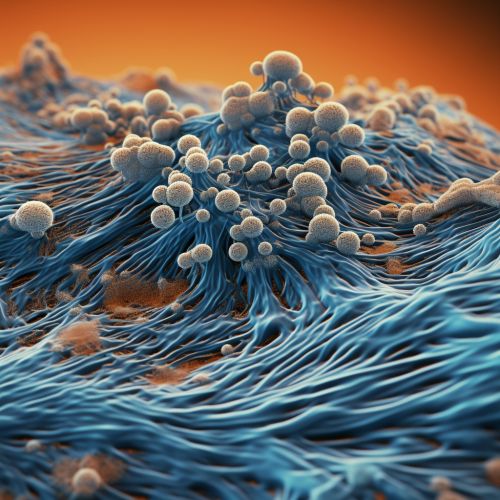Pneumocystis jirovecii
Introduction
Pneumocystis jirovecii is a yeast-like fungus of the genus Pneumocystis. The causative organism of Pneumocystis pneumonia, it is an important human pathogen, particularly among immunocompromised hosts. Infections caused by this organism have been associated with high morbidity and mortality rates in patients with HIV/AIDS, making it a significant concern in the medical community.
Taxonomy and Nomenclature
The organism was initially named Pneumocystis carinii, but subsequent research revealed that the Pneumocystis organisms found in rats and humans are distinct species. The human pathogen was renamed Pneumocystis jirovecii in honor of the Czech parasitologist, Otto Jirovec, who first identified the organism in humans.
Morphology
Pneumocystis jirovecii is a small, unicellular organism that exhibits a unique combination of fungal and protozoan characteristics. It exists in two morphological forms: a cystic form (trophozoite) and a non-cystic form (sporozoite). The cystic form is the infectious stage of the organism, while the non-cystic form is responsible for the replication and propagation of the organism within the host.


Life Cycle
The life cycle of Pneumocystis jirovecii is not fully understood, but it is believed to include both sexual and asexual stages. The organism reproduces asexually by binary fission, and sexually through the production of spores. The spores are released into the environment and inhaled by a susceptible host, leading to infection.
Pathogenesis and Clinical Manifestations
Pneumocystis jirovecii primarily infects the lungs, causing a form of pneumonia known as Pneumocystis pneumonia (PCP). The organism attaches to the alveolar lining of the lungs, causing inflammation and damage to the lung tissue. Clinical manifestations of PCP include fever, cough, shortness of breath, and weight loss. In severe cases, the disease can lead to respiratory failure and death.
Diagnosis
Diagnosis of Pneumocystis jirovecii infection is typically made by identifying the organism in respiratory specimens obtained through bronchoalveolar lavage or induced sputum. The organism can be visualized using various staining techniques, including Gomori methenamine silver (GMS) stain and Giemsa stain. Molecular techniques, such as polymerase chain reaction (PCR), can also be used for detection and identification of the organism.
Treatment and Prevention
The first-line treatment for Pneumocystis pneumonia is a combination of trimethoprim and sulfamethoxazole (TMP-SMX). In cases of intolerance or resistance to TMP-SMX, alternative therapies such as pentamidine, dapsone, or atovaquone can be used. Prophylactic administration of TMP-SMX is recommended for individuals with a high risk of PCP, such as those with HIV/AIDS or those receiving immunosuppressive therapy.
Epidemiology
Pneumocystis jirovecii is a globally distributed organism, with cases of PCP reported in all parts of the world. The organism is believed to be transmitted through the airborne route, with humans serving as the primary reservoir. The incidence of PCP has decreased significantly since the advent of antiretroviral therapy for HIV/AIDS, but the disease remains a significant cause of morbidity and mortality among immunocompromised individuals.
Research and Future Directions
Research into Pneumocystis jirovecii is ongoing, with efforts focused on understanding the organism's biology, pathogenesis, and resistance mechanisms, as well as developing new diagnostic methods and treatments. Future directions in the field include the development of a vaccine and the identification of novel drug targets.
